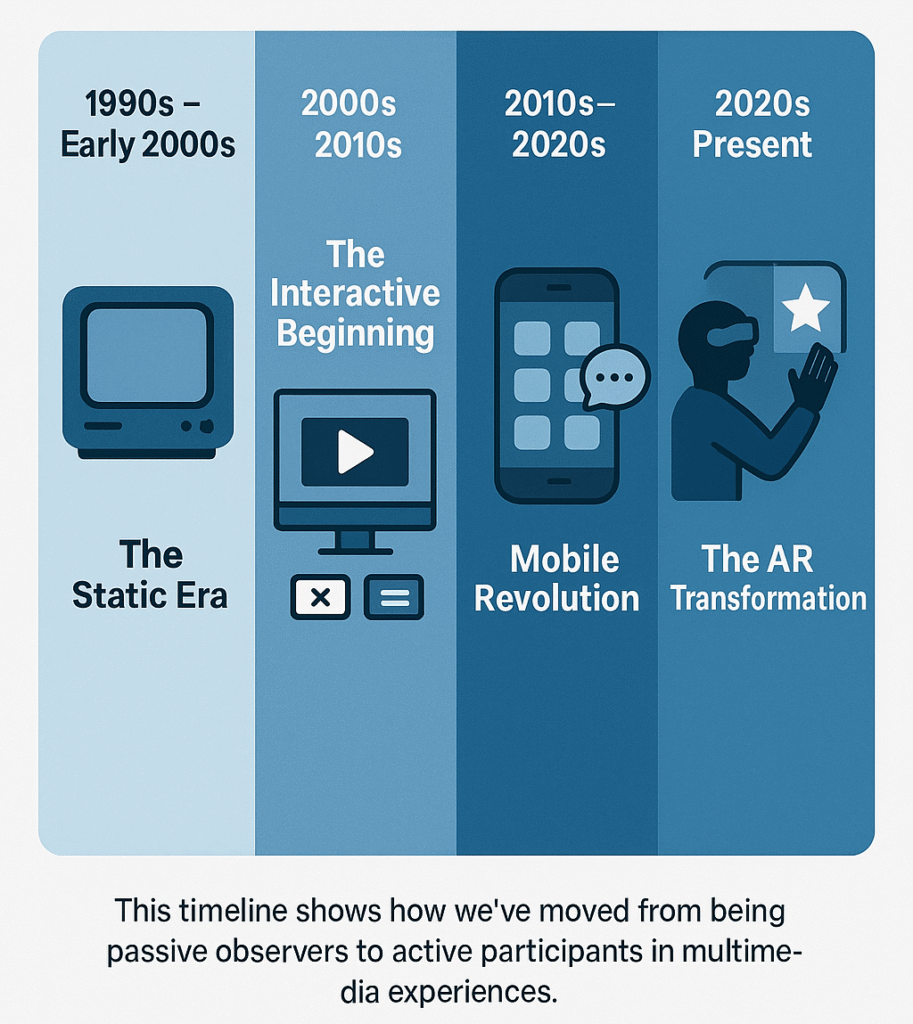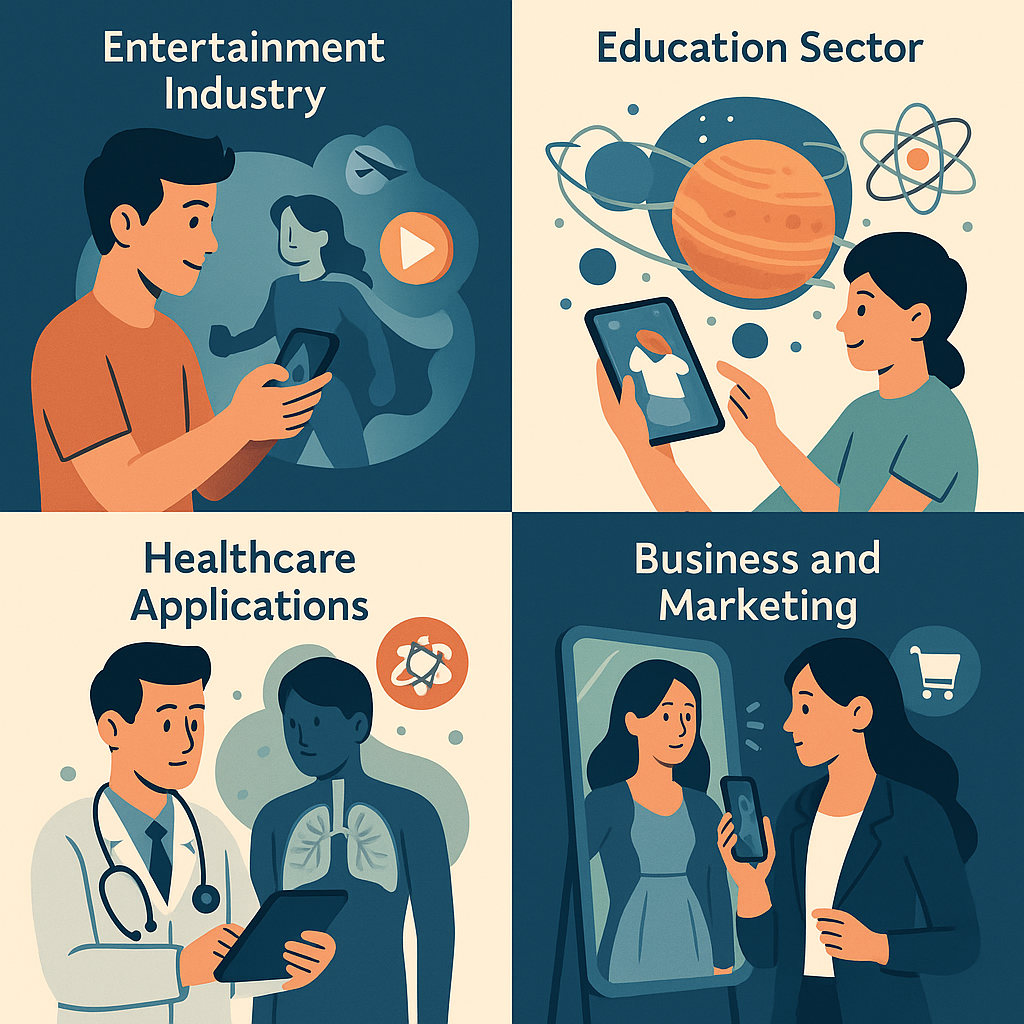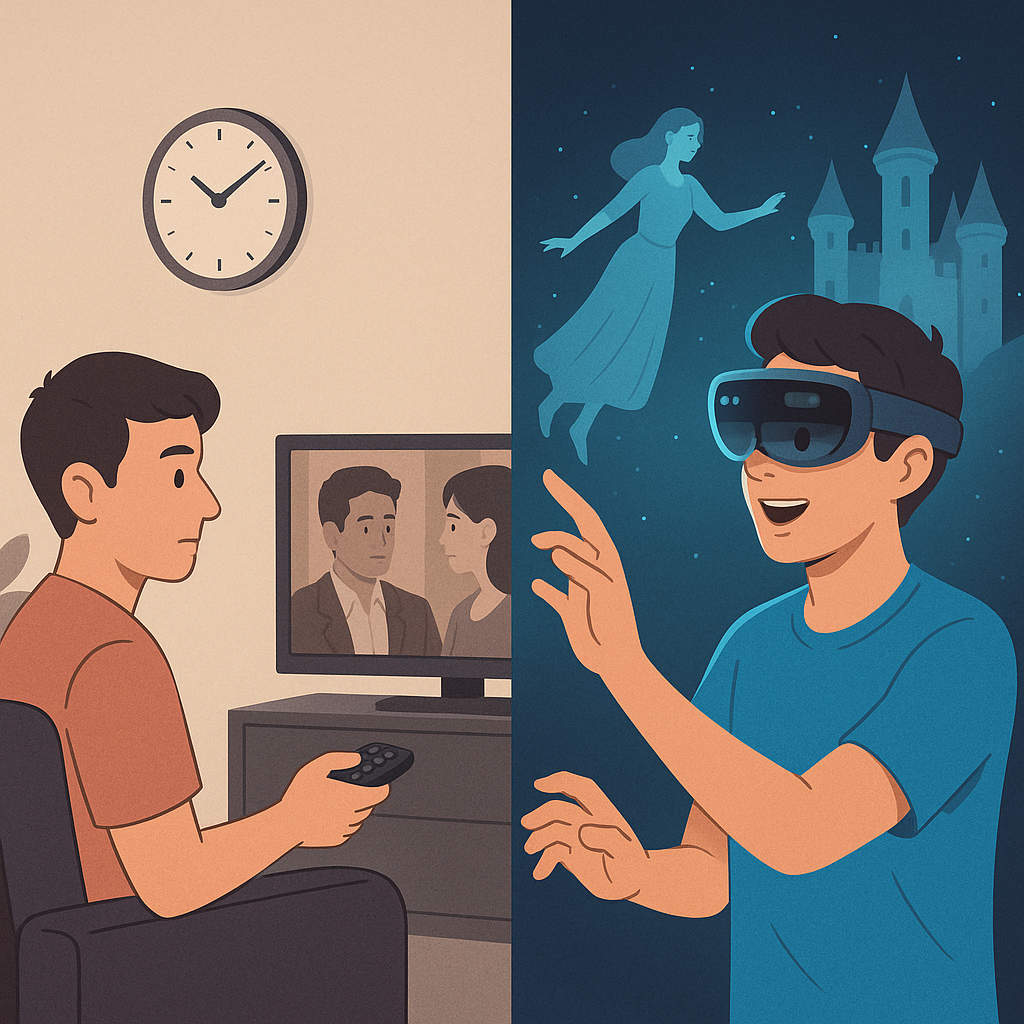Have you ever wondered what it would be like to step inside your favorite movie or have digital characters walk into your living room? This isn’t science fiction anymore – it’s the reality of augmented reality in multimedia. AR technology is revolutionizing how we consume, create, and interact with digital content, making experiences more immersive than ever before.
From social media filters that turn us into cartoon characters to educational apps that bring historical figures to life, AR is reshaping the multimedia landscape. This transformation affects everything from entertainment and education to marketing and social interaction. Let’s explore how this groundbreaking technology is changing the way we experience digital content.
Table of Contents
What Is Augmented Reality in Multimedia?
Augmented reality in multimedia combines digital elements with the real world to create enhanced experiences. Unlike virtual reality, which creates entirely digital environments, AR overlays computer-generated content onto our physical surroundings. This technology uses cameras, sensors, and sophisticated algorithms to blend digital and physical worlds seamlessly.
Think of AR as a bridge between traditional multimedia content and interactive experiences. When you use a smartphone app to see how furniture looks in your home before buying it, or when you point your phone at a restaurant menu to see 3D images of dishes, you’re experiencing AR multimedia.
The technology works by recognizing objects, surfaces, or markers in the real world and then adding digital information on top. This creates a multimodal experience that engages multiple senses and makes content more memorable and engaging.
The Evolution of Multimedia: From Static to Interactive

1990s – Early 2000s: The Static Era
- What We Had: Basic videos, static images, and simple audio files
- User Experience: Pure consumption – watch, listen, observe
- Limitations: One-way communication, no personalization, limited engagement
- Example: Watching movies on VHS tapes or DVDs with no interaction possible
2000s – 2010s: The Interactive Beginning
- What We Had: Flash animations, clickable content, basic web interactivity
- User Experience: Limited interaction through buttons and menus
- Limitations: Still largely predetermined experiences, minimal personalization
- Example: Educational CD-ROMs with clickable elements and simple quizzes
2010s – 2020s: The Mobile Revolution
- What We Had: Touchscreen interfaces, mobile apps, social media integration
- User Experience: Touch-based interaction, sharing capabilities, basic customization
- Limitations: Interaction limited to screen boundaries, no real-world integration
- Example: Interactive mobile games and social media platforms with user-generated content
2020s – Present: The AR Transformation
- What We Have: Augmented reality in multimedia, real-world digital overlays, immersive experiences
- User Experience: Complete interaction – manipulate, explore, become part of the content
- Advantages: Personalized experiences, real-world integration, multimodal engagement
- Example: AR movie experiences where viewers step into scenes, interact with characters, and influence storylines
This timeline shows how we’ve moved from being passive observers to active participants in multimedia experiences. The shift from static consumption to interactive participation has fundamentally changed how we define and experience digital entertainment.
7 Ways AR Is Changing Multimedia Experiences
1. Enhanced Social Media Content
Social media platforms have embraced AR to create more engaging content. Instagram and Snapchat filters don’t just add fun effects – they represent a fundamental shift in how we create and share multimedia content. These filters use facial recognition and motion tracking to overlay digital elements in real-time, creating personalized multimedia experiences.
The impact goes beyond entertainment. Brands like Sephora use AR filters for marketing, allowing customers to virtually try makeup products before purchasing. Similarly, Nike’s AR features let users see how different sneakers look on their feet through their smartphone cameras. This interactive content generates higher engagement rates compared to traditional posts, proving that AR multimedia experiences resonate more strongly with audiences.
2. Immersive Educational Content
Education has been transformed by AR multimedia applications. Students can now dissect virtual frogs, explore ancient civilizations, and witness historical events unfold in their classrooms. Apps like Google Expeditions allow teachers to take students on virtual field trips to historic sites, while platforms like Merge EDU enable hands-on learning with 3D objects that students can manipulate and explore.
This multimodal approach to learning engages visual, auditory, and kinesthetic learners simultaneously. Traditional educational multimedia relied on textbooks, videos, and static presentations. AR brings subjects to life, making abstract concepts tangible and memorable. Students retain information better when they can interact with content rather than simply observe it.
3. Revolutionary Gaming Experiences
Gaming represents one of the most successful applications of AR multimedia. Games like Pokémon GO demonstrated how AR can blend digital entertainment with physical activity and real-world exploration. Players don’t just watch game content – they become active participants in multimedia experiences that span both digital and physical spaces.
Modern AR games like Harry Potter: Wizards Unite and Minecraft Earth create persistent virtual worlds overlaid on real locations. The success of these games has led to the development of ARKit and ARCore, platforms that enable developers to create sophisticated AR gaming experiences. This creates ongoing multimedia experiences that evolve over time, keeping players engaged longer than traditional games.
4. Transformed Retail and E-commerce
Online shopping has been revolutionized by AR multimedia experiences. Customers can now try on clothes virtually, see how products look in their homes, and interact with 3D product models. IKEA’s Place app lets customers visualize furniture in their actual rooms, while Warby Parker’s virtual try-on feature allows users to see how glasses look on their faces before ordering.
Without AR, online shopping relied on static images and descriptions. Now, customers can visualize products in their own environment, reducing uncertainty and increasing purchase confidence. Major retailers like Amazon and Walmart have invested heavily in AR technology, with Amazon’s AR View feature becoming a standard shopping tool. This transformation has made e-commerce more engaging and effective.
5. Enhanced Live Events and Entertainment
Concerts, sports events, and theater performances are incorporating AR to create more immersive experiences. During Super Bowl performances, artists like The Weeknd have used AR effects that viewers can access through their phones to see additional visual layers. Music festivals now offer AR apps that provide real-time information about performers, schedules, and interactive games.
This technology transforms passive audience members into active participants. Instead of simply watching a performance, audiences can access layered content that enhances their understanding and enjoyment of the event. Unity’s AR Foundation has made it easier for event organizers to create these immersive experiences.
6. Innovative Marketing and Advertising
Marketing has embraced AR to create memorable brand experiences. Instead of traditional advertisements, brands now offer interactive content that allows customers to engage with products and services in meaningful ways. Burger King’s “Burn That Ad” campaign used AR to let customers virtually burn competitors’ advertisements to receive free Whopper coupons.
AR marketing campaigns generate higher engagement rates because they provide value beyond simple promotion. Customers remember interactive experiences more than traditional ads, making AR an effective tool for brand building. Companies like 8th Wall provide platforms that make AR marketing accessible to businesses of all sizes.
7. Personalized News and Information
News organizations are using AR to make stories more engaging and understandable. Complex data can be visualized in 3D, historical events can be recreated, and breaking news can be experienced rather than just read about. The New York Times has used AR to show readers 3D models of archaeological discoveries, while BBC has created AR experiences that let users explore historical events like the Apollo moon landing.
This approach makes information more accessible and memorable. Readers can explore news stories from multiple angles, leading to better understanding of complex topics. WebAR technology has made it possible for news organizations to deliver AR experiences directly through web browsers without requiring app downloads.
The Technology Behind AR Multimedia
AR multimedia experiences rely on several key technologies working together:
Computer Vision & Machine Learning
- These technologies help devices “see” and understand the real world by identifying objects, surfaces, and movements
- Machine learning continuously improves recognition accuracy, making AR experiences more reliable over time
- Real-life example: Instagram filters that recognize your face and track facial movements to apply makeup effects or animal ears in real-time
Advanced Graphics Processing (GPU)
- Powerful processors render realistic digital content that blends seamlessly with physical environments
- Modern mobile GPUs can handle complex AR processing in real-time without lag
- Real-life example: IKEA Place app that renders 3D furniture models in your room with realistic lighting and shadows that match your actual environment
Mobile Device Power
- Today’s smartphones and tablets have enough processing power to run sophisticated AR applications
- This democratization means millions of people can access AR multimedia experiences without expensive specialized equipment
- Real-life example: Pokémon GO running smoothly on regular smartphones, overlaying animated creatures onto real-world locations using just your phone’s camera and sensors
Cloud Computing
- Provides additional processing power for complex AR applications that exceed device capabilities
- Enables developers to create sophisticated multimedia experiences that work across different devices and platforms
- Real-life example: Google Maps Live View that processes street imagery in the cloud to provide AR walking directions with arrows and labels overlaid on your camera view
Benefits and Challenges of AR Multimedia
Benefits
AR multimedia offers numerous advantages over traditional content formats. Interactive content increases engagement and retention rates significantly. Users spend more time with AR experiences compared to passive content consumption.
The technology also enables personalized experiences that adapt to individual preferences and contexts. This level of customization was impossible with traditional multimedia formats.
AR multimedia can also bridge language and cultural barriers by using visual and interactive elements that transcend text-based communication.
Challenges
Despite its potential, AR multimedia faces several challenges. Technical limitations include battery drain, processing requirements, and the need for robust internet connections. These factors can limit user adoption and experience quality.
Privacy concerns also arise as AR applications often require access to cameras and location data. Users must balance the benefits of enhanced experiences with potential privacy risks.
Development costs remain high, making it challenging for smaller creators to produce quality AR multimedia content. This could limit the diversity of available experiences.
Impact on Different Industries

Entertainment Industry
Movie studios and musicians are creating AR experiences to boost engagement and marketing reach.
Practical Applications:
- Movie promotions: Studios release AR apps where fans can bring movie characters into their homes for photos and videos
- Concert enhancement: Musicians use AR to display floating lyrics, visual effects, or virtual band members during live shows
- Interactive movie posters: Scan a poster with your phone to watch exclusive trailers or behind-the-scenes content
Entertainment companies partner with AR developers to create apps that fans download. Users simply point their phones at specific triggers (posters, album covers, or designated spaces) to unlock exclusive AR content.
Education Sector
Schools and universities are replacing traditional teaching methods with hands-on AR learning experiences.
Practical Applications:
- Science classes: Students dissect virtual frogs or explore the solar system in 3D without leaving the classroom
- History lessons: Ancient civilizations come alive as students walk through virtual Roman forums or Egyptian pyramids
- Medical training: Students practice surgeries on virtual patients before working with real ones
Teachers use AR-enabled tablets or smartphones with educational apps. Students point devices at textbooks, worksheets, or designated areas to see 3D models, animations, and interactive content that explains complex concepts.
Healthcare Applications
Medical professionals are using AR to improve patient care, training, and surgical precision.
Practical Applications:
- Patient education: Doctors show patients 3D models of their organs or conditions, making diagnoses easier to understand
- Surgical planning: Surgeons overlay digital images onto patients’ bodies to see exactly where to make incisions
- Medical training: Students practice procedures on virtual patients that respond realistically to their actions
Healthcare providers use specialized AR devices or tablets with medical software. For surgeries, imaging data (like MRI scans) is processed and displayed as 3D overlays during operations, giving surgeons X-ray vision.
Business and Marketing
Companies are replacing traditional advertising with interactive AR experiences that customers can engage with.
Practical Applications:
- Product trials: Customers virtually try on clothes, makeup, or see how furniture looks in their homes before buying
- Interactive advertisements: Billboards and print ads come alive when scanned, showing product demos or special offers
- Employee training: Workers learn new skills through AR simulations that are safer and more cost-effective than real-world training
Businesses create AR apps or partner with existing platforms. Customers download apps or use built-in phone features to scan QR codes, logos, or products. The AR experience then guides them through product information, purchases, or training modules.
The Future of AR Multimedia
The future of AR multimedia looks incredibly promising. As technology continues to advance, we can expect even more realistic and seamless integration between digital and physical worlds. 5G networks will enable more complex AR experiences with reduced latency and improved performance.
Artificial intelligence will make AR multimedia more intelligent and responsive. Content will adapt in real-time to user preferences and behaviors, creating truly personalized experiences.
We’re also likely to see AR multimedia expand into new industries and applications. Healthcare, architecture, and manufacturing are already beginning to adopt AR for training, visualization, and operational purposes.
Conclusion
Augmented reality in multimedia is not just a technological trend – it’s a fundamental shift in how we create, consume, and interact with digital content. This technology has transformed passive multimedia consumption into active, engaging experiences that blur the lines between digital and physical worlds.
The impact of augmented reality extends far beyond entertainment. From education and healthcare to marketing and social interaction, AR multimedia experiences are reshaping how we learn, work, and connect with others. As technology continues to advance, we can expect even more innovative applications that will further transform our digital experiences.
The future of multimedia is interactive, immersive, and personalized. Organizations and individuals who embrace AR technology now will be better positioned to take advantage of the opportunities this revolutionary technology presents. Whether you’re a content creator, educator, marketer, or simply someone interested in the latest technological developments, understanding AR multimedia is essential for navigating our increasingly digital world.
As we move forward, the question isn’t whether AR will continue to change multimedia experiences – it’s how quickly we can adapt to and leverage these powerful new capabilities. The revolution has begun, and those who embrace it will shape the future of digital content creation and consumption.
Frequently Asked Questions
Q: What devices do I need to experience AR multimedia?
A: Most modern smartphones and tablets can run AR applications. You don’t need expensive specialized equipment – your existing mobile device likely supports AR experiences.
Q: How is AR different from VR in multimedia applications?
A: AR overlays digital content onto the real world, while VR creates completely virtual environments. AR multimedia experiences blend digital and physical elements, while VR multimedia immerses users in entirely digital spaces.
Q: Can AR multimedia work offline?
A: Some AR applications can work offline, but many require internet connectivity for full functionality. The complexity of the AR experience determines whether offline operation is possible.
Q: Is AR multimedia safe for children?
A: AR multimedia can be safe for children when used appropriately. Parents should monitor usage time and ensure children understand the difference between digital and real-world elements.
Q: How much does it cost to develop AR multimedia content?
A: Development costs vary widely based on complexity and features. Simple AR experiences can be created relatively affordably, while complex applications require significant investment.
Q: What industries benefit most from AR multimedia?
A: Education, entertainment, retail, healthcare, and marketing industries have seen the most significant benefits from AR multimedia adoption.

Pingback: Creating Immersive Content promoting 360 Degree Multimedia